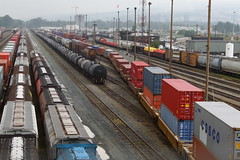 In 1998, a panel of experts convened by the California Air Resources Board concluded that regularly breathing in diesel engine exhaust at work raises a worker’s risk for asthma, lung cancer and chronic obstructive pulmonary disease (COPD). This was true even after factoring in the effects of smoking by employees.
In 1998, a panel of experts convened by the California Air Resources Board concluded that regularly breathing in diesel engine exhaust at work raises a worker’s risk for asthma, lung cancer and chronic obstructive pulmonary disease (COPD). This was true even after factoring in the effects of smoking by employees.
The findings should not have surprised anyone because, as the panel’s report notes,
Diesel exhaust includes over 40 substances that are listed by the United States Environmental Protection Agency (U.S. EPA) as hazardous air pollutants and by the ARB as toxic air contaminants. Fifteen of these substances are listed by the International Agency for Research on Cancer (IARC) as carcinogenic to humans, or as a probable or possible human carcinogen. Some of these substances are: acetaldehyde; antimony compounds; arsenic; benzene; beryllium compounds; bis(2-ethylhexyl)phthalate; dioxins and dibenzofurans; formaldehyde; inorganic lead; mercury compounds; nickel; POM (including PAHs); and styrene.
Those toxic components often trigger and exacerbate asthma. For instance, writing in a 2009 issue of Occupational and Environmental Medicine, researchers noted, “Workers in jobs with diesel exhaust exposure had an increased risk of COPD mortality relative to those in unexposed jobs. Workers hired after the introduction of diesel locomotives[after World War II] had a 2.5 percent increase in COPD mortality risk for each additional year of work in a diesel-exposed job.”
Going back to the California air quality panel report, the experts reviewed more than 30 studies and determined that “occupational exposures to diesel exhaust were associated with a 40 percent increase in the relative risk of lung cancer.”
LEARN MORE
- Railroads Must Reduce Employees’ Exposure to Diesel Exhaust Fumes
- On-the-Job Exposures to Toxic Materials Put Railroad Employees at Risk for Leukemia, Other Blood Cancers
- What Is the Federal Employers Liability Act (FELA)?
Our Virginia-based FELA law firm often finds reasons to cite these and numerous other more-recent studies on the link between work-related diesel fume exposures and lung disease. Many of the clients we represent in cases brought under the provisions of the Federal Employers Liability Act spent their careers working on and around trains with diesel-powered locomotives.
Diesel also fuels many of the trucks deployed for right of way and signal maintenance, generators used to power tools used to make track repairs, and standing engines for cranes and hoists in rail yards. Railroad workers simply cannot avoid breathing in some diesel exhaust.
The result is a high prevalence of debilitating and deadly lung diseases among career railroaders. Uncontrollable asthma, emphysema, COPD, all forms of lung cancer and mesothelioma afflict retired rail employees regardless of the jobs they performed. Trackmen, repairers and signalmen are as at risk as engineers, machinists and conductors.
Freight railroads such as CSX and Norfolk Southern can do much to reduce their employees’ exposure to diesel exhaust fumes. Most of the steps would cost very little up front while also sparing physical and financial problems down the road.
For instance, redesigning jobs to limit workers’ time around idling diesel locomotives costs nothing. Suppling and requiring respirators for employees who cannot avoid workspaces suffused with diesel exhaust does incur costs, but the dollars saved on future FELA claims and health care more than make up the initial expenses. Ensuring all newly acquired locomotives come equipped with air conditioning, pressurized crew cabs, and exhaust stacks designed to shunt fumes around the cab could limit diesel fume exposures to engineers and conductors to almost zero.
The time for rail corporations to implement such safety measures has long passed. Protecting workers would also bolster their bottom lines.
EJL